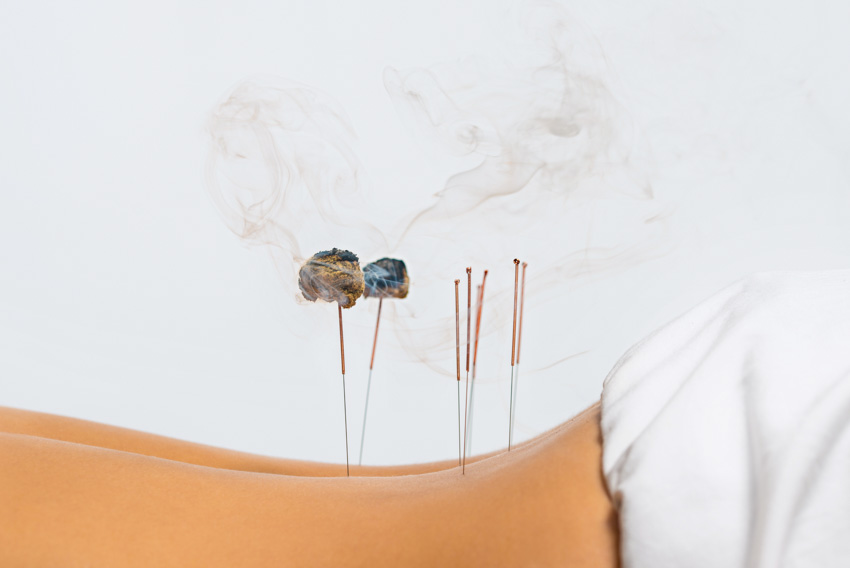
Acupuncture reduces pain and inflammation for patients with lumbar disc herniations. Kaifeng People's Hospital researchers compared warm needle acupuncture with standard acupuncture. Warm needle acupuncture reduced serum levels of proinflammatory biochemicals more effectively than standard acupuncture. In addition, warm needle acupuncture was more effective at reducing overall pain levels and restoring daily function. [1]
Before and after treatment, patients’ serum levels of TXB2, TNF-α, and IL-6 were recorded and analyzed. Japanese Orthopedic Association (JOA) and Oswestry Disability Index (ODI) scores were used to assess function for activities of daily living. Visual Analog Scale (VAS), Present Pain Intensity (PPI), and Pain Rating Index (PRI) scores were used to quantify changes in pain levels.
Proinflammatory biochemical serum levels (measured in picograms per milliliter) dropped in both groups, with the warm needle acupuncture group demonstrating a more marked improvement for TXB2, TNF-α, IL-6, and TXB2. The warm needle acupuncture group changed from 81.36 (pg/mL) ±10.96, 54.56 ±4.31, and 21.45 ±3.19 to 35.42 ±7.26, 28.04 ±3.56 and 12.42 ±2.01, respectively.
JOA and ODI scores improved more significantly in the warm needle acupuncture group, falling from 13.85 ±4.12 and 35.02 ±3.61 to 21.12±3.25 and 18.23±2.76, respectively. The same is true for all three pain indicators. The VAS, PPI, and PRI scores decreased from 6.54 ±0.98, 3.31 ±0.82, and 8.16 ±1.24 to 2.31 ±0.54, 2.10 ±0.64 and 6.09 ±1.07 in the warm needle acupuncture group. The standard acupuncture control group experienced a smaller benefit from 6.61 ±0.78, 3.26 ±1.10, and 8.18 ±1.31 to 2.79 ±0.58, 2.98 ±0.73, and 7.28±1.14, respectively.
Learn more about low back pain treatments in the HealthCMi online acupuncture continuing education course entitled Low Back Pain. HealthCMi CEU credit is valid throughout the entire USA, Canada, New Zealand, Australia, and more. All courses are NCCAOM pre-approved and PDAs are automatically credited for you. The same holds for Florida CEs, which are automatically sent to CE Broker. All courses are approved for specialty certifications from the California Acupuncture Board, the Texas State Board of Acupuncture Examiners, the State of Illinois (IDFPR), and much more!
In this investigation, a total of 90 patients were randomized into two groups. The standard acupuncture control group was comprised of 23 males and 18 females. Patient age ranged from 33 to 66 years, with a mean age of 44.5 ±0.6 years. Disease course ranged from 1 day to 3 months. Average disease course was 21.3 ±6.8 days.
The warm needle acupuncture group was comprised of 23 males and 36 females. Patient age ranged from 34 to 69 years, with a mean age of 46.5 ±0.6 years. Disease course ranged from 2 days to 2.5 months. Average disease course was 20.8 ±6.8 days. No patients had undergone treatment of any other form or had been suffering from severe cardiovascular diseases. CT or MRI were conducted for diagnosis of the specific pain area prior to admittance to the study. Patients primarily had pain at the lumbar vertebrae regions of L1–L5 and S1.
For both groups, bilateral Jiaji (EX-B2) points at the local pain areas were selected as main acupoints. Supplementary points were added based on individual conditions. For those with pain along the taiyang meridian, the following points were used:
- BL60 (Kunlun)
- BL36 (Chengfu)
- BL54 (Zhibian)
- BL58 (Feiyang)
- BL40 (Weizhong)
For those with pain along the shaoyang meridian, the following points were used:
- GB41 (Zulinqi)
- GB31 (Fengshi)
- GB30 (Huantiao)
- GB40 (Qiuxu)
- GB34 (Yanglingquan)
For both groups, each acupuncture treatment lasted for 30 minutes and one treatment was applied per day, with 5 days completing a session. Three sessions were given in total. The control group solely received regular manual acupuncture while moxa was used to administer warm needle acupuncture in the other group. Warm needle acupuncture was applied after achieving deqi. Needles on bilateral Jiaji points were connected to a 2.5 cm moxa piece. For the supplementary points, needles were manipulated every ten minutes. The results of this study indicate that warm needle acupuncture is an optimal treatment for lumbar disc herniation patients with the ability to reduce pain and improve body function.
Reference:
[1] Zhang Yuehua, Clinical Observation of Treating Lumbar Disc Herniation with Warm Acupuncture, Journal of Practical Traditional Chinese Internal Medicine, 2021-09-14.


